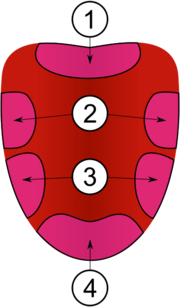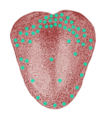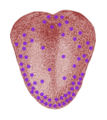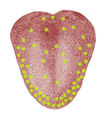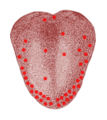Tongue tastes
| Students @ Work - a student collaborative writing project. Help us by providing feedback on the Discussion page. |
| Instant wiki maker | Making handouts | Editing tips |
Contents
- 1 Student worthiness
- 2 Primary biological content area covered
- 3 Materials
- 4 Handouts
- 5 Description of activity
- 6 Lesson plan
- 7 Potential pitfalls
- 8 Math connections
- 9 Literature connections
- 10 Connections to educational standards
- 11 Next steps
- 12 Reflections
- 13 Citations and links
- 14 Common mistakes
Biology In Elementary Schools is a Saint Michael's College student project from a course that ran between 2007 and 2010 and fully described in this book chapter. The student-created resources have been preserved here for posterity. Link under 'toolbox' for printer-friendly versions of the exercises. Click on handouts to print full resolution versions. Please see Wikieducator's disclaimer, our safety statement, and the Creative Commons licensing in English and in legalese.
Student worthiness
Tried at least once and worked well!
This lesson has been done with small groups of about six or seven second grade students. In practice it went very well and was both entertaining and informative for the students. These young students were very excited to share their prior knowledge and to learn more about their bodies. It is a very good lesson to use with lower grade levels in elementary schools.
Primary biological content area covered
The biological content are that will be covered in this activity is the five senses, in particular the sense of taste. It will show children how different people taste different tastes on different parts of their tongues and how taste buds can be sensitive to specific tastes.
Taste buds are sensory organs that are found on your tongue and allow you to experience tastes that are sweet, salty, sour, and bitter. The bumps on your tongue are called papillae. The tiny hairs on them, microvilli, send messages to the brain about the taste being sweet, sour, salty or bitter. The olfactory receptors in your nose also work in the taste process by sending messages to the brain. Everyone's tastes are different. Your tastes will change as you get older. In the past, scientists thought taste buds were in the same places for everyone. Today we know that they are in different spots for everyone. This experiment will help demonstrate that.
Materials
Safety Equipment (for teachers)
- Sterile Gloves
Materials for each student group
- small paper/plastic cups
- water
- unsweetened baking cocoa
- lemon juice
- salt
- honey
- paper towels
Materials for each student
- paper
- pencils
- coloring materials (crayons, colored pencils, or markers)
- stickers (four different colors)
- a tongue
Handouts
The students will receive the following handout that will allow them to identify the location on their tongue where they find they taste each taste the strongest. Here is a link to the PDF file of the handout.
Apart from these four tastes there is a fifth taste known as umami. It is a taste that is combinations of all the four tastes i.e, sweet, salt, sour and bitter. Taste buds detecting Umami are found in all regions of the tongue where taste buds are found. Examples of foods rich in umami tastes include tomatoes, mushrooms, cheese, green tea, shell fish, and breast milk.
Description of activity
- Our tongues have four basic types of taste buds: sweet, sour, bitter, and salty.
- These taste buds are on different parts of our tongues.
- Most people taste sweet on the tips of their tongues, bitter on the back, sour on the sides, and salty near the front and sides. However, research today has come to the conclusion that this may not be the case for everyone. That is why this experiment will show the differences in students and see how right or wrong the old hypothesis was.
Procedure
- Teacher will put on gloves.
- Each substance (lemon juice, salt, unsweetened cocoa, honey) will be put into a small cup, water may be needed to make the consistencies the same.
- The teacher will put a little of the first substance, say lemon juice onto the cotton swab.
- Students will sit in a row and one by one the teacher will put the lemon juice onto each section of the tongue.
- After the teacher places the substance on one part of the tongue, they will drink water to clean their palette.
- The student will then report where they feel the taste the strongest by coloring on their tongue handout the appropriate section.
- Then, once again they will take a sip of water to clean their palette.
- Next, the second substance of your choice will be placed on the cotton swab and then on the four parts of the tongue.
- After each student does the four tastes they will then be handed stickers.
- Each sticker will represent a different sense, bitter, salty, sour, and sweet and they will put their initials on their four stickers.
- Then they will put their personal stickers on the big tongue map.
Lesson plan
Grade: 3rd Time: 20 Minutes
- First 5 minutes:
- Introduce activity to students
- Give background on taste, and how different parts of the tongue have different sensory receptors for different tastes.
- Explain where the taste receptors are located on the tongue.
- Explain what the students will be doing with the big tongue map and the stickers.
- Show them an example with either a student or one of the teachers.
Next 10 minutes:
- Put each of the different items on each of the students' tongues.
- When students think they know what taste it is (bitter, sweet, salty, or sour) have them put the colored sticker (with their initial on it) on the map.
- Repeat the process to each student
Last 5 minutes:
- Look at the tongue poster created, is it similar?
- Have them talk about what they learned
- Clean up anything needed
- Have students wash their hands and explain to them the importance of keeping hands clean and out of mouths.
Potential pitfalls
There could be potential pitfalls with the materials the students will be putting on their tongues. If they are unwilling to try something it could make the experiment less effective. However, when we performed this experiment the students were all willing to try the materials on their tongue. Having the cup of water nearby helps gets rid of any fears.
We will also have to be very careful about the sanitation factor and making sure everything is sterile and clean. It will be a good opportunity to teach the students about what is unsafe to swallow.
This activity can also get a little messy with students accidently spilling the supplies so keep paper towels handy!
Math connections
This activity can be connected to math at the end of the experiment through a graph. Students are going to put a circle sticker where they feel they tasted the item. The teacher could add up each type of taste on each area of the tongue. Then, the teacher could plot this in many different graph forms to see the differences.
Literature connections
This activity can be connected to children's literature. There is a great book, "The Senses:Taste". by Angela Royston. It explains how the taste senses work. It talks about different tastes, taste buds, and how smell and taste are connected. You could read this book before doing the activity to give students a background on what the taste buds are.
This book cited is: Royston, A; 2005; The Senses: Taste; Black Rabbit Books.
Connections to educational standards
3.5 Students make informed, healthy choices that positively affect the health, safety, and well-being of themselves and others.. This is evident when students:
- 3.5.a. Explain how childhood injuries and illnesses can be prevented and treated
- 3.5.e. Demonstrate refusal skills to enhance health
7.14 Students demonstrate understanding of the human body heredity, body systems, and individual development and understand the impact of the environment on the human body
- 7.14.b. Identify the parts of the human body, and demonstrate understanding of how the parts work together to perform functions that satisfy common needs
Next steps
The other information that could be pulled from the materials and resources that we used for the activity could be individual differences. Even though we briefly mentioned that this would be a result of the activity it would be interesting to hear more from the students on what they observed. We focused a lot on the actual tasting and taste buds but interesting information could definitely be seen by the diversity of results.
There are definitely different activities that could be done using the same resources and materials. Using each of the different flavors (lemon juice, salt, cocoa, and honey) you could have each student be blind folded and have to guess the taste. This of course would be somewhat similar to the activity that we did but it would be a good way for the students to use their sense of taste without knowing what the flavor is.
Not many students gave their own input on the activity but in order for everyone to get the full learning experience making sure that each student has the opportunity to do the activity is important. This allows for more data to be collected and gives a wider range of results.
Reflections
After doing this activity with grade school students we found that it worked quite well. It was visual with the diagrams of the tongues and gave the students hands on experience. All the students understood the directions which gave a sense that it wasn't too challenging of an activity. It was helpful that most students had prior knowledge of the four different tastes that your tongue can sense (salty, sweet, bitter, and sour). This gave the students the ability to know what to look for while tasting each flavor.
Having a group of three worked in our favor. It was much easier to get the activity completed having more hands. We were a little caught off guard in the beginning because even though we prepared most of the cups before hand we still had to fill them with water. The students were ready to go before we were fully set up so the beginning of the activity was a little hectic. Once we gathered the students and explained what the goals were for the activity it was smooth sailing.
If there was one thing that I would say the activity absolutely needed was the final tongue map with the stickers of each student's individual findings. This really allowed for the students to see how everyone's taste buds are different. It gave a complete visual that was insightful and quite helpful. Also using rubber gloves is absolutely necessary in order to keep germs and disease away. A helpful hint: If you are the only teacher presenting this activity with a full class it may be easier to have only a few children do the actual activity if you are limited in time. If time is not a problem then having the full class do the activity is most effective.
All in all this activity was fun and gave the students a meaningful experience that can work into their everyday lives. It was an easy way to experiment with tastes and provides a hands on activity that allows for fun learning!
Citations and links
Parts of this activity was taken from Zoom (http://pbskids.org/zoom/activities/sci/tonguemap.html)
MLA CITATION:
"ZOOM . activities . sci . Tongue Map | PBS Kids." PBS KIDS: Educational Games, Videos and Activities For Kids! Web. 2 Feb. 2010. <http://pbskids.org/zoom/activities/sci/tonguemap.html>.
Common mistakes
This section is strictly for editorial suggestions and will not be part of your final product. The most common editorial suggestions I make are listed here.
| Work in progress, expect frequent changes. Help and feedback is welcome. See discussion page. |





